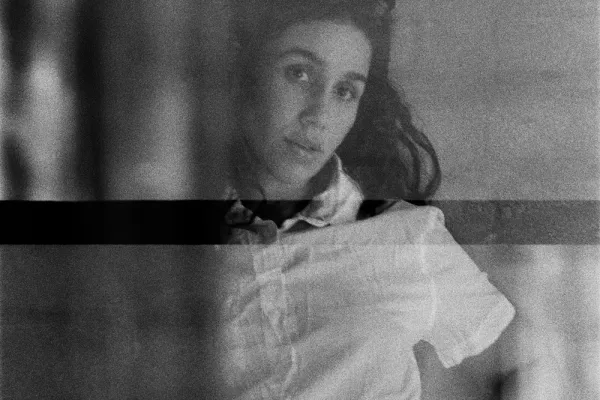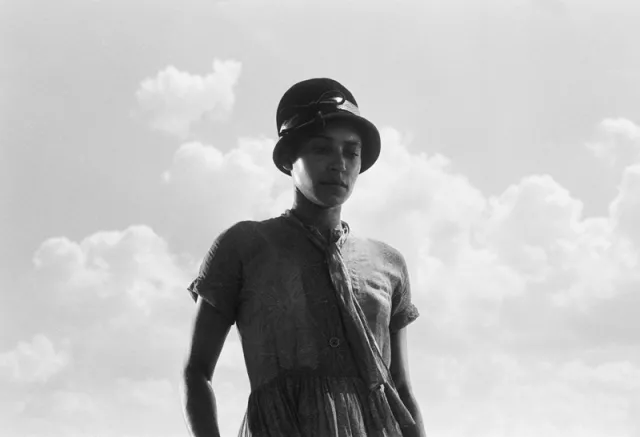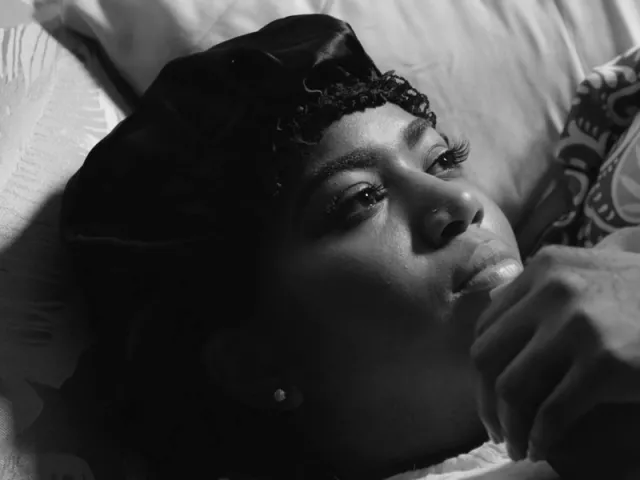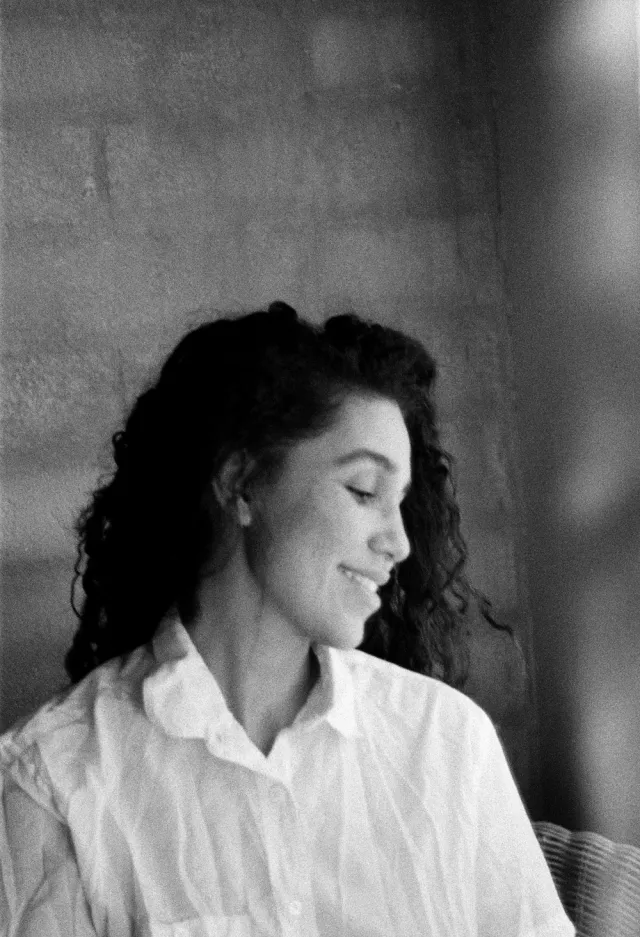The Word Is ‘Love’
Alum News
Visionary filmmaker Garrett Bradley ’07 is using her art to expose the injustices of the world and inspire a path to healing and universal connection.

Published April 6, 2022
Garrett Bradley ’07 does not want to be seen. Not by me; not today. It’s a brisk fall afternoon and we are on a video call, but Bradley has requested that our cameras remain off. I comply, and ask the award-winning auteur Zooming in from Los Angeles to describe herself. “I’m a light-skinned Black woman with freckles, braids, a tank top, and some jeans. And I’m barefoot,” she says.
Her straightforward description belies the enormity of what the rest of the world sees: a 35-year-old film virtuoso who is bending genres, redefining narratives, and breaking new ground for artists of every stripe. In 2017, her short film Alone took the top prize for documentary shorts at the Sundance Film Festival. This was followed by a series of highly lauded projects: America, which was the centerpiece of a recent exhibition at New York’s Museum of Modern Art; her first full-length documentary feature, Time, on the challenges of the prison system, which was nominated for a 2020 Academy Award and netted her the Sundance award for best director of a U.S. documentary; and a three-episode miniseries for Netflix about top-ranked tennis player Naomi Osaka.
The Sundance directorial award for Time was a first for a Black woman, likely one of many firsts to come for Bradley. On the face of it, this recognition is to be celebrated, but, upon deeper reflection, the nod is far more complicated. For Bradley, in 2020, to be the first Black woman to break through the celluloid ceiling reflects how grievously inadequate the film industry has been in honoring diverse talent.
“Any first is a melancholy kind of experience,” she says. “There were moments of feeling guilty, feeling shame … just trying to wrap my head around what the award really meant.” Yet, Bradley is willing to put what she calls “the disappointment of history” aside in service of her broader vision: “to create more visibility around what is working and, in doing so, support a better future.”
The future Bradley envisions is one that rights injustices. Her responsibility, she says, is to reveal them. In Time, she highlights the impacts of mass incarceration by telling the story of Fox and Rob Richardson, and Fox’s long struggle to win her husband’s release from a 60-year sentence for armed robbery. The film’s title is not only a nod to his prison sentence, but also to what is lost by the more than 2 million people who are behind bars; to the children, partners, and families whose lives have also been upended; and to a system that seems to leach the humanity out of those tasked to uphold it.
Bradley’s films interrogate capitalism, culture, and the quest for justice.
Bradley underscores this loss through her use of nearly two decades’ worth of Fox’s home video footage, weaved seamlessly into a narrative that filmmaker Ava DuVernay called “a seminal cinematic work [that] must be seen.”
Yet, what makes Time remarkable is that it is not simply a film about indelible absence; it is in equal measure a study of resilience. In a conversation with DuVernay, Bradley described the film as an exploration of “what it means to hope and evolve as a human being, and grow and create revolutions within yourself.”
Bradley’s goal, she tells me, was to not only interrogate the specificity of hope as explored through the Richardsons, but to ask, “What will sharing [their stories] do for those families?” This curiosity around impact is what helps Bradley create work that she describes as “additive, rather than extractive.”
CREATIVE LIFE
From a young age, Bradley, who grew up in New York City, was taught that it was perfectly acceptable to build a life around what she cherished, rather than what brought her the biggest paycheck. “For me, a big part of joy was communicating in a way that I felt was effective, and a desire for that communication to heal people and help people better understand themselves and the world that we’re living in,” Bradley says. Her parents—artists Suzanne McClelland and Peter Bradley—nurtured her to think beyond a traditional 9-to-5 existence. “They helped me understand the ebb and flow of having money and not having money, and how to use the money I had to support my craft,” she recalls. Beyond these pragmatic lessons, she says her parents’ creative lives instilled in her a “profound idea of what was possible.”
Bradley arrived at Smith in the fall of 2003 with a keen sense of curiosity and wonder. She was intent on studying art history, not because of her early exposure to art but rather because of her dyslexia. Images, Bradley explains, “allowed me to act on my curiosity with a level of confidence that I otherwise didn’t feel.”
As Bradley immersed herself in art, she found herself drawn to the stories behind the works, many of them religious. “There was this Dutch painting class my first semester of my first year, and a conversation around [Johannes] Vermeer’s relationship to Catholicism through his painting Allegory of the Catholic Faith. We were talking about the painting on a formal level, which I was intrigued by, but more broadly I wanted to better understand how [his story] and the image worked together.”
That interest led her to the religion department, where, in the classrooms of professors including Joel Kaminsky and Andy Rotman, she discovered the essential ingredients for how to make movies: stories, images, and the interactions between them. “It opened up this whole other world that was connected to images but also had elements of philosophy and storytelling.”
Bradley’s studies also seeded one of the hallmarks of her filmmaking: the interplay between the seen and unseen. In Judaic philosophy, she explains, the depiction of God is considered sacrilegious. It is in direct contrast to the Hindu precept of darshan, where, she explains, sight is equal to prayer. “You have two completely different ways of achieving spiritual connection, both reflecting the human experience in super interesting ways.”
Bradley’s films are notable for their unique aesthetic and tone: the creative use of natural sound and silence and the interplay of light and dark.
Darshan, derived from the Sanskrit word for “sight,” is a devotional practice. “In the ritual context, one comes before a deity [or holy person, or sacred object] and, through the visual exchange, receives a blessing,” Professor Rotman explains. But pull back a bit further and darshan can be perceived as a way of connecting with the world as a whole. “When you’re engaging with a visual object, it’s part of an interaction, and you feel like you’re developing a relationship to it,” he says. “The visual forms are not just imparting information to you, and you’re not just extracting information from them—you’re enmeshed. It’s a way of thinking about visual forms as a kind of community building.”
Bradley credits Rotman with helping her form “a holistic, 360-degree framework around movie-making” that preceded her awareness that she would become a filmmaker. Rotman isn’t surprised. “Garrett had this amazing ability to come into a wide variety of situations, be comfortable in her skin, and allow others to feel comfortable,” he says. This level of awareness—“to read a room and respond”—makes her valuable to those who are part of her work, as well as those who witness it. “Garrett doesn’t inhabit the comfortable distance that some—especially documentary filmmakers—do,” he says. She finds “a way into familiarity” with her subjects that “beckons” viewers. “You feel involved, and in that immersive experience, you’re transformed.”
EMPATHY ON FILM
After completing her bachelor of arts degree at Smith and, in 2012, a master of fine arts in directing from the UCLA School of Theater, Film and Television, Bradley began to forge a body of work that not only interrogated capitalism, culture, and the quest for social justice, but also imbued in viewers a sense of possibility that—to paraphrase author Arundhati Roy—a better world is coming. In Below Dreams—an official entrant in the 2014 Tribeca Film Festival—Bradley takes her audience into the lives of residents of New Orleans who struggle to navigate work, love, and the weight of everyday life while holding firm to their visions of better lives.
Ashley Clark, curatorial director at film distributor The Criterion Collection, which recently released Time on Blu-ray, says that though they are different in form and content, Bradley’s early works are “united by a calm observance and human empathy.” Her aesthetic and tone, he says, are unmistakable: a meticulous ear for the use of music, natural sound, and silence; a sharp eye for the interplay of light and dark; long, hypnotic zooms; and elliptical yet harmonic editing.

In America, Bradley celebrates Black lives, Black history, and Black talent by reimagining lost moments in African American cinema.
These techniques are stunningly evident in her 2019 work, America, what New York Times co-chief art critic Roberta Smith describes as a “quicksilver, imperious video installation … an indictment wrapped in a celebration.” The series of short films is a twofold reclamation—first, of the estimated 70 percent of domestic feature-length movies made between 1912 and 1929 that were discarded as studios transitioned from silent films to sound, and second, of the Black talent that was prevented from fully flourishing.
“America was important to my development as a filmmaker, or as a maker of any sort,” Bradley says. It was the first time she had worked with archival footage, and that work helped solidify a visual and narrative philosophy that carried through to Time. “When we watch archival material, we intuitively are picking up on the 360 degrees of history—of the present moment and of the future—which is in total contradiction to the linearity of making films,” she says. “America allowed me to become more confident and agile with material that I, myself, didn’t create. It helped me to understand what it means to make something that appears fixed, flexible.”
The 12 black-and-white shorts that constitute America are intercut with segments from Lime Kiln Club Field Day, a 1913 film thought to be the very first feature-length film with an all-Black cast and an integrated production team. Collectively, they give form to what was and what can be. For Bradley, America “functions off the assumption that there was a whole breadth of work that was equally as progressive as this one film, [a series that] proposes that if we have examples of a past that are progressive, it might inform our sense of our present selves.”

A scene from Alone, Bradley’s Sundance award-winning documentary about the impact of mass incarceration on Black families in America. The film is told through the eyes of a single mother in New Orleans.
America, Ashley Clark says, “marked the arrival of an extraordinary talent who was concerned with seriously interrogating the history and present of the Black American image on film, in an idiosyncratic and deeply artistic way.”
When I ask Bradley if this high praise induces anxiety or instills pressure to champion Black representation, she remains dispassionate: “I associate pressure with expectation, and expectation with a preconceived notion of something. I’m not actually interested in that,” she says. “I try as much as possible to think about where there are problems and how my work can, to a certain extent, create not even a resolution but some kind of step forward … an alternative to a problem. That’s as much as I can hope for. How my work ends up getting received or defined is not up to me.”
REVEALING POINTS OF CONNECTION
There is a montage about 23 minutes into America that I found myself repeatedly returning to. A barbed-wire fence gives way to a group of joyful Black boys crowding a balloon stand. The close-up of balloons overtakes the screen just before the camera pans down to a Black man whose arms slowly open toward the sky. These visuals are interspersed with shots of Black children, sparkling shards of glass, and a stunning Black girl in a white cotton dress turning a mirror toward sunlight—all set against an ambient soundtrack punctuated by birds, cicadas, and the uncomfortable screech of latex balloons being knotted. Ashley Clark describes this scene as a reflection of “joy, and the possibility of freedom; beauty, but with an aching undertow.” He suggests that the through line of Bradley’s work is care. But what crystallizes for me—in the birdsong and outpouring of light—is love.
I share this interpretation with Bradley. “Absolutely yes,” she says. “Part of that effort around making connections is simply put in one word, which is love.” Art’s purpose, she believes, is to “help nudge us in the direction of understanding and seeing, and being able to participate in the world’s connectedness, rather than its division.”
This response foreshadows Bradley’s upcoming project: a film version of author Octavia Butler’s staggeringly prescient text Parable of the Sower. The novel, published in 1993, is set in the dystopian future of 2024—one plagued by climate disasters, the dissolution of democracy, and extreme economic inequality. Butler’s writing is categorized as science fiction, but it is firmly grounded in what readers can recognize in our history and lived experiences. “Octavia was somebody who was really paying attention, and valued the here and the now,” Bradley says. “Although she didn’t consider herself to be particularly religious, a lot of us might look at her work and consider it prophetic.”
I am reminded of one of the most indelible parts of the text: “All that you touch, you change,” Butler writes. “All that changes, changes you. The only lasting truth is change. God is change.”
From a commercial perspective, Parable of the Sower will be Bradley’s most ambitious work as a director: a feature-length interpretation of a cherished novel, financed and distributed by A24, the company behind contemporary classics including Minari, Moonlight, and Uncut Gems. But what I am most curious about is what Bradley herself defines as her greatest achievement. Although I can’t see her, I sense the question gives her pause. “I don’t think that I’ve taken time to think about that,” she says, inhaling deeply and responding slowly. “On a personal level, that’s something I’ll have to sit with. But, professionally, if the people I’ve had the opportunity to work with feel that their life has benefited from the work we’ve done—if they feel that the world is becoming a more just and transparent and loving place as a result of the things that we’ve collaborated on—I can’t imagine any other pursuit more important.”
Simran Sethi ’92 is an award-winning journalist and scholar and a 2009 recipient of the Smith College Medal.
This story appears in the Spring 2022 issue of the Smith Alumnae Quarterly.
Garrett Bradley on What Inspires Her
Reading
“I’m most inspired by what makes me feel present and connected. That starts with reading articles, newspapers, and books that I can touch, like Roxanne Dunbar-Ortiz’s book An Indigenous Peoples’ History of the United States. To a certain extent, everything I’m thinking about right now stems from that text, and from reorienting myself around how I define myself as an American. I’m asking the question, If we really want to create change, how does self-identification play into that? And I’m looking at Sun at Night, a catalog from conceptual artist Shilpa Gupta. I had an opportunity to see her installation in London at the Barbican, and I’m just completely inspired by it. I’m still learning [her work], but am so thankful to have new things in my purview.”
Listening
“I haven’t been dancing since the pandemic, so I listen to the music I would have heard every Saturday night at The Pink Room in New Orleans. It’s a whole bunch of mixes and remixes of house music by Lil Jodeci. I don’t even know all [the artists’] names; it’s just these wonderful three-hour-long playlists I listen to every day.”
Walking
“Growing up in New York shaped my need to both be around people and to walk in order to think. I need to step into things I can feel on a physical level, because I believe nothing really has an impact unless its outcomes happen in the real world—in the street. It’s crucial to our survival that we find a way to feel comfortable in three-dimensional space and be in the world with things we can actually touch and [connect] with. That includes engaging with strangers.”
As a filmmaker with a number of award-winning documentaries to her credit, Garrett Bradley ’07 seeks to expose injustices and then work to right them. Photographs by BLVXMTH

